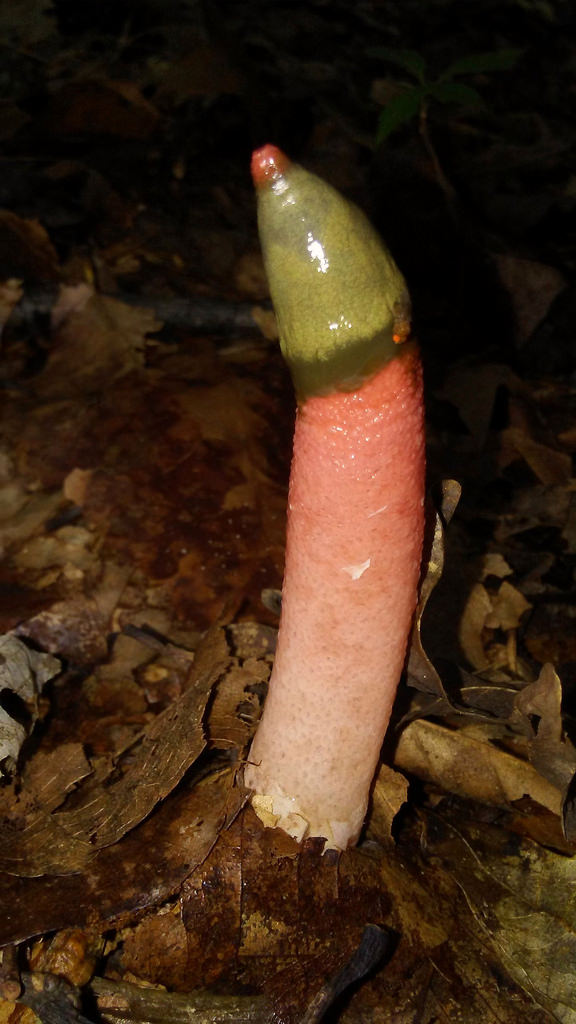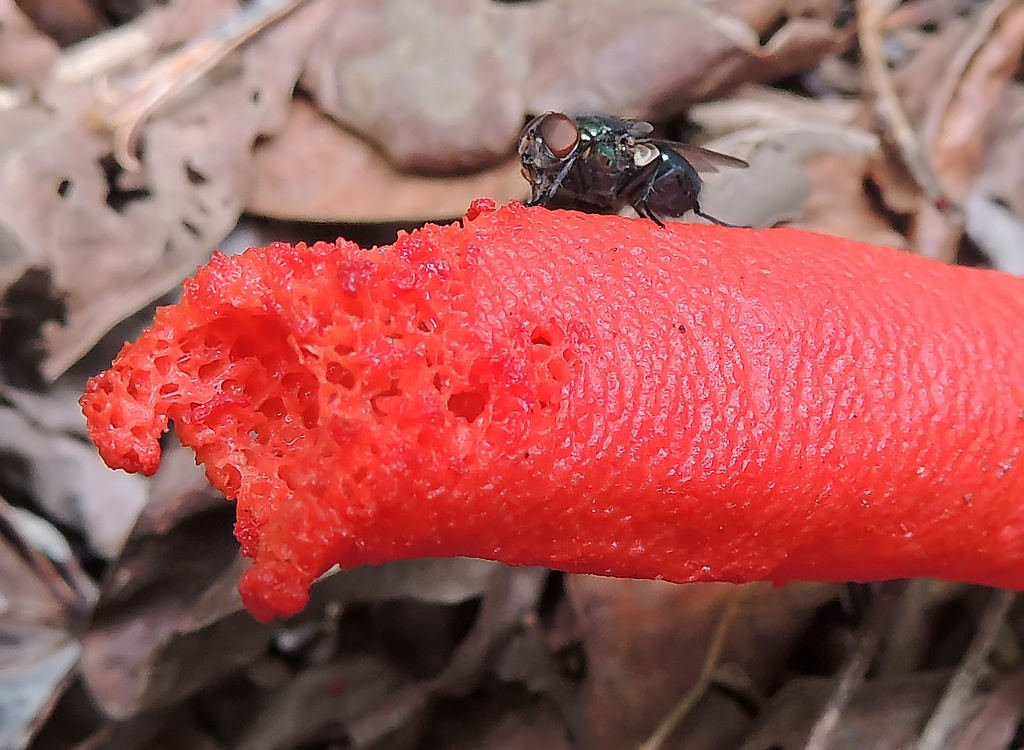Map Snapshot









18 Records
Status
It is necessary to revisit the Mutinus genus as we are now aware of at least three species, some of whose fruiting bodies can be told with a fair amount of certainty without spore examination. Not all fruiting bodies can be told without spores (and two of the species have almost identical-size spores), but it is possible to make educated guesses for some photos (J. Solem, pers. comm., 2/25/2018).
Description
From J. Solem (pers. comm.) (f.b.==fruiting body):
M. elegans - the only current Mutinus species in MBP. Most stinkhorns are found on the ground on wood chips or woody debris. The foul odor attracts flies and other insects; they disperse the spores.
--f.b. below head minutely pitted
--head gradually tapered
--f.b. usually slightly curved
--f.b. sometimes whitish/orangish/orange-red
--slimy head has ragged lower edge
--spores: 4-7 x 2-3 microns
M. ravenelli - on ground, on wood chips, mulch, decaying wood.
--f.b. below head with fairly large pits
--head stout, slightly swollen
--f.b. below head pinkish-rose
--head 3-5 cm, abrupt lower edge
--pore at apex (usually white volval remains)
--spores: 3-5 x 1.5-2 microns
M. caninus - may have to wait for additional research as this one used to be the one usually pictured in field guides but, just to add to the possibilities, here are characteristics (as defined by Kuo on his website and Baroni in his field guide--those are the major references I used to separate all three species).
--slightly smaller than other two
--f.b. orangish to orange-red--may be uniformly colored
--head is 2-3 cm, slime doesn't last long
--f.b. often has clinging volval remnants at base
--spores 3.5-5 x 1.5-2 microns
An additional similar reddish stinkhorn is Phallus rubicundus. In the Mutinus genus the gooey spores are found on the main fruiting body, not on a separate 'head.' In P. rubicundus, the 'head' is separate and only attached at the top of the stalk; the lower part usually stands out slightly from the rest of the f.b. The best way to determine that is to slice an entire f.b. lengthwise to see the attachment point, or note a cap whose lower edge seems to stand well away from the stalk.
Where To Find
Most stinkhorns are found on the ground on wood chips or woody debris. The foul odor attracts flies and other insects; they disperse the spores.
Seasonality Snapshot
Source: Wikipedia
| Mutinus | |
|---|---|

| |
| Mutinus caninus | |
| Scientific classification | |
| Domain: | Eukaryota |
| Kingdom: | Fungi |
| Division: | Basidiomycota |
| Class: | Agaricomycetes |
| Order: | Phallales |
| Family: | Phallaceae |
| Genus: | Mutinus Fr. (1849) |
| Type species | |
| Mutinus caninus (Huds.) Fr. (1849)
| |
| Synonyms[1] | |
Mutinus is a genus of fungi in the family Phallaceae. The genus was first described by Elias Magnus Fries in 1849. According to the Dictionary of the Fungi (10th edition, 2008), the widespread genus contains 12 species.[2]
Species
[edit]Source:[3]
- Mutinus albotruncatus
- Mutinus annulatus
- Mutinus argentinus
- Mutinus bicolor
- Mutinus boninensis
- Mutinus bovinus
- Mutinus caninus – dog stinkhorn
- Mutinus cartilagineus
- Mutinus coracoideus
- Mutinus curtisii
- Mutinus discolor
- Mutinus elegans – elegant stinkhorn
- Mutinus fleischeri
- Mutinus granulatus
- Mutinus inopinatus
- Mutinus minimus
- Mutinus muelleri
- Mutinus penzigii
- Mutinus proximus
- Mutinus ravenelii - Ravenel's red stinkhorn
- Mutinus rugulosus
- Mutinus sulcatus
- Mutinus verrucosus
- Mutinus watsonii
- Mutinus xylogenus
- Mutinus zenkeri
Etymology
[edit]The genus name Mutinus was a phallic deity, Mutunus, one of the Roman di indigetes placated by Roman brides.[4]
References
[edit]- ^ "Synonymy: Mutinus Fr". Species Fungorum. CAB International. Retrieved 2011-07-11.
- ^ Kirk PM, Cannon PF, Minter DW, Stalpers JA (2008). Dictionary of the Fungi (10th ed.). Wallingford, UK: CABI. p. 445. ISBN 978-0-85199-826-8.
- ^ "Species Fungorum - Mutinus". www.speciesfungorum.org. Retrieved 2022-07-10.
- ^ Arora, David (1986). Mushrooms Demystified. Berkeley, California: Ten Speed Press. p. 771. ISBN 0-89815-169-4.
External links
[edit]- "Mutinus Fr". Atlas of Living Australia.

